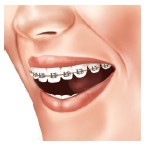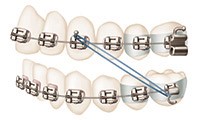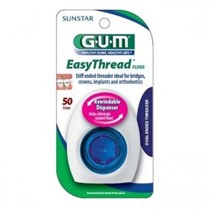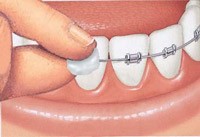Orthodontic Care
I have braces or retainers.
While undergoing orthodontic treatment with braces or retainers, it is important to keep the mouth very clean through thorough and frequent oral hygiene routines, including between-teeth cleaning, to keep the braces or retainers clean, and to maintain a healthy and balanced diet.

KEEPING YOUR MOUTH AND BRACES CLEAN
 Figure: Orthodontic braces are wires held in place by brackets held to the tooth with strong dental adhesive.
Figure: Orthodontic braces are wires held in place by brackets held to the tooth with strong dental adhesive.First, follow any advice that your orthodontist or dental hygienist provided. While wearing braces, special attention needs to be given to cleaning your teeth and the orthodontic appliance as both dental plaque and food particles can easily get trapped between the teeth and gums and the appliance.
Here are some commonly accepted recommendations for toothbrushing:
- Remove any rubber bands fitted to the appliance (you will need to replace them with new ones after brushing).

- Use a specially designed brush for orthodontics (with “V” cut bristles) such as the GUM® Orthodontic toothbrush. Apply fluoride toothpaste. Brush at least twice a day and if possible after every meal.
Note: If you prefer to use a regular toothbrush, that’s OK. Just make sure you use a high-quality brush that has tapered bristles such as the GUM® Technique® Deep Clean or GUM® Technique® Complete Care to reach in all the difficult-to-clean areas.
- Place the brush at a 45-degree angle to the tooth, pointing toward the gums and use a gentle circular motion on each tooth, ensuring the bristles can reach into the gaps between the teeth and under and around the brackets and wires of the appliance.
- Brush on both the outside and inside surfaces of all teeth, and do not forget the biting surfaces too.
- The whole procedure should take about three or more minutes to do thoroughly. When you think you have finished, spit out the toothpaste and check in a mirror to make sure there are no bits of food still trapped anywhere.
- Perform your regular between-teeth cleaning with either floss or interdental brushes. If using floss, a floss-threader will help thread the floss between the teeth and under the wires. You can also use small specially designed “inter dental brushes” or GUM® Soft-Picks® that reach between the teeth and remove the dental plaque as effectively as dental floss.
- Don’t forget to re-apply any rubber bands.
- If you notice any bleeding from the gums or small white spots appearing on any of your teeth visit your dental professional.

KEEPING YOUR RETAINER CLEAN
Once your braces are removed and you have received your retainer, the job of tooth movement is not yet over. A retainer is a custom-made, removable appliance that helps hold the teeth in their new position until the teeth, bone, gums, and muscles fully adapt to the change. The retainer is made of clear plastic or acrylic and maybe some metal wires that support the teeth and hold the retainer in place.
Clean your retainer thoroughly at least once per day to keep it fresh and free from dental plaque bacteria:
- Rinse your retainer when you remove it.
- Use a soft toothbrush, without toothpaste as it may scratch the plastic and brush all surfaces, especially those that fit against the tissues of the mouth. The nylon bristles should not scratch the plastic if used gently. Some gentle hand-soap can be used if you wish.
- Occasionally soak the retainer in a baking soda solution or a proprietary denture cleanser. This will help stop the development of any odors.
- Before replacing your retainer, clean the rest of your mouth as normal.
- Do not use bleach or household cleaners. They may burn your mouth.
- Do not place the retainer in a dishwasher as the heat may warp it.
- When not wearing the retainer, always clean it first, dry it, and then place it in the retainer case.
- Don’t forget to wear your retainer – or all the time and money spent on your new appearance and smile will be wasted!
IF YOUR BRACES RUB AND YOU GET MOUTH SORES
Orthodontic wax can help relieve pain and irritation caused by orthodontic appliances. A small pea-size amount can be placed over the bracket or wire that is rubbing. Cleanse your hands and brush your teeth before applying the wax. Make a small ball out of the wax and cover each of the problematic areas. Remove the wax before toothbrushing and replace it afterwards with a new piece.
If your braces start rubbing and sores form between your normal orthodontic appointments, check with your orthodontist or dentist as it may be that a wire or bracket has broken and should be repaired.
 Figure: Orthodontic wax helps relieve the pain and irritation caused by appliances’ rubbing. Use only a small ball to cover any parts that seem to be causing the soreness.
Figure: Orthodontic wax helps relieve the pain and irritation caused by appliances’ rubbing. Use only a small ball to cover any parts that seem to be causing the soreness.

